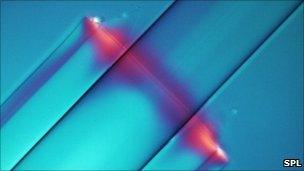Fibre optic capacity 'auto-tuned' by novel device
- Published

Light micrograph of a fibre optics cable
Scientists have shown off a system they say could "substantially" improve the data capacity of fibre optic networks.
The team says the growth in bandwidth-hungry applications such as YouTube and iPlayer will eventually stretch the limits of long-distance fibre links.
Their improved system would eliminate most of the interference caused by other signals and amplifiers, in an analogue of "auto-tune" software.
Developers say the device can plug directly into existing networks.
Data is sent as a sequence of bits coded into the properties of a light beam piped down an optical fibre, but the bits can over great lengths of fibre become distorted.
That can occur because of so-called phase noise - imperfections in reproducting exactly when different parts of the light signal arrive - or because of "cross-talk", signals sent down a fibre that influence one another.
The result is that the sharp-edged jumps of a digital signal are degraded into ever-more unintelligible squiggles.
While these sources of noise can be overcome with existing electronics, the result is a reduced data capacity; the total capacity that an optical fibre can support vastly exceeds that provided by current electronics.
Now, an EU-funded team has demonstrated a device that can "clean up" a noisy signal and re-transmit it with fuller capacity.
The prototype device makes use of advances both in optical fibre technology and in lasers, which are used to "lock on" to the signal and distinguish it from noise.
"With this demonstration we've shown that it is possible to use the capabilities of the optical fibre to the full without being restricted by the capabilities of the electronics," said Periklis Petropoulos, a researcher on the project from the University of Southampton's Optoelectronics Research Centre.
The output signal is returned to its sharp-edged nature at the precise digital levels that are needed; it is, in one sense, like a fibre-optic version of the auto-tune software that "cleans up" singers' voices.
"You could say that in its final functionality, it is like auto-tune," Dr Petropoulos told BBC News.
Long haul
Sebastien Lahtinen of broadband use website ThinkBroadband said the advance was of particular interest for long-haul links, in which data cables stretch across continents and oceans.
"This may help to get faster Internet to many African countries which have recently benefitted from a new fibre optic cable that runs around the sea border," he said.
"In terms of next-generation broadband, the main problem in the UK is getting fibre as close to the home as possible rather than capacity over those fibres," he told BBC News, "(so) I don't think it's something that will benefit the increasing rollout of broadband."
Dr Petropoulos stressed that the device was a laboratory demonstration, some way from industrial application - but that similar technology would become essential in a world where bandwidth needs are always on the rise.
"The technologies we are using in today's networks will not see us through for much longer into the future."
"Devices like these will become a necessity to be employed in our telecommunications networks," he said.
- Published28 July 2010